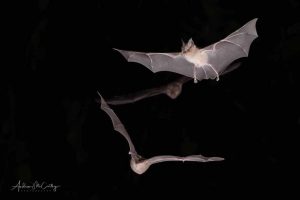12th December 2023
We were treated to an inspirational talk from Andrew McCarthy FRPS, on British Wildlife.
Andrew is a Photographer, Conservationist and Ecologist (an Environmental Consultant) and he has a Fellowship in Natural History Photography from the Royal Photographic Society (FRPS). Andrew also sits on the Fellowship and Associate Distinction panels for the RPS. He advocates for the RPS Nature Group, as being a great resource for all photographers interested in natural world photography (see rps.org/groups/nature/). Note: The Group has recordings of recent presentations so take a look.
Andrew started his photography in 2004 on a Canon digital camera and has progress through Fuji, Nikon and Sony to become an OM-1 ambassador (note: Andrew can provide any member with discount codes if interested in OM-1 equipment).
The first part of Andrew’s talk was about large animals; deer, foxes, otters and bats. The latter requires a lot of specialist equipment, but has produced many beautiful images (click on the example below). Andrew is a licensed Bat ecologist, so can get access to bats not available (understandably) to others. He advocated getting down to the animals eye level (even on water), to create many interesting images.
Andrew also used some old images, which originally he didn’t feel were good enough, but with modern editing software great images can be produced. So review older images, don’t throw them away.
Andrew works on various trans-location projects, snakes and amphibians. This gives him unique access to them and allows more great images to be captured. There was a collection of newts photographed in tanks. These were lit from behind and through a piece of white perspex. This gives an even bright light, showing off the translucent features of these beautiful creatures.
The second half of Andrew’s presentation was about insects (“smaller critters”). This included many of Andrew’s Fellowship panel images. Andrew flagged that early morning is the best time to try can capture Butterfly images. Once they have warmed up they are too mobile and frustrating to capture. His preference is to capture his subjects “doing something”.
Many of Andrew’s images were captured in his back garden and many of his panel images on his Garden pond. So it isn’t always necessary to travel great distances to get great images. He finds that having a project or objective useful when planning his outings and has found the journey from LRPS to FRPS to be extremely useful in improving his photography.
Many of Andrew’s images are a single shot, but for some he uses focus stacking. Originally he had to manually focus stack (focus on the nearest point of the subject take an image, rotate the barrel a little and take another image, and so on), today many cameras have automated stacking capability. Usually Andrew takes between 15 – 30 frames, but that can vary to just a handful or up to 100 for very small subjects. Andrew recommended starting and ending each set of stacks by taking a single image of your hand, so that you know where each stack begins and ends. He uses Helicon Focus to stack the resultant images.
More examples of Andrew’s work can be found here:
Website: andrewmccarthyphotography.co.uk
Facebook: www.facebook.com/andrewmccarthyphotography
Instagram: www.instagram.com/andrewmccarthyphoto

